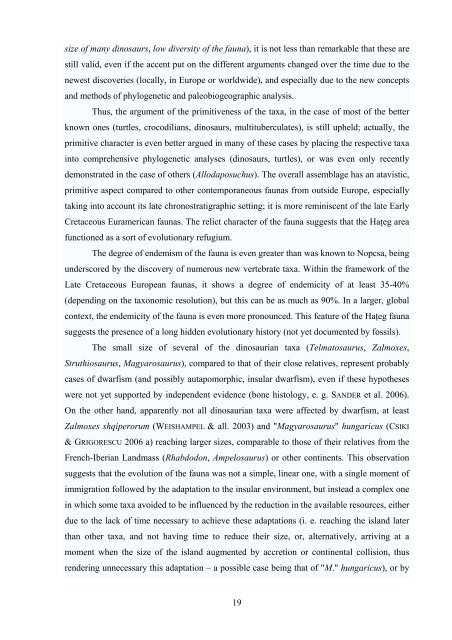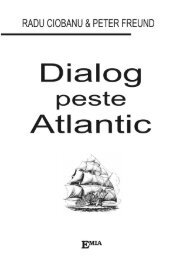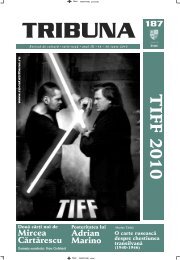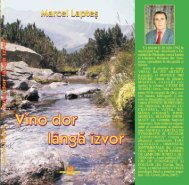size of many dinosaurs, low diversity of the fauna), it is not less than remarkable that these arestill valid, even if the accent put on the different arguments changed over the time due to thenewest discoveries (locally, in Europe or worldwide), and especially due to the new conceptsand methods of phylogenetic and paleobiogeographic analysis.Thus, the argument of the primitiveness of the taxa, in the case of most of the betterknown ones (turtles, crocodilians, dinosaurs, multituberculates), is still upheld; actually, theprimitive character is even better argued in many of these cases by placing the respective taxainto comprehensive phylogenetic analyses (dinosaurs, turtles), or was even only recentlydemonstrated in the case of others (Allodaposuchus). The overall assemblage has an atavistic,primitive aspect compared to other contemporaneous faunas from outside Europe, especiallytaking into account its late chronostratigraphic setting; it is more reminiscent of the late EarlyCretaceous Euramerican faunas. The relict character of the fauna suggests that the Haţeg areafunctioned as a sort of evolutionary refugium.The degree of endemism of the fauna is even greater than was known to Nopcsa, beingunderscored by the discovery of numerous new vertebrate taxa. Within the framework of theLate Cretaceous European faunas, it shows a degree of endemicity of at least 35-40%(depending on the taxonomic resolution), but this can be as much as 90%. In a larger, globalcontext, the endemicity of the fauna is even more pronounced. This feature of the Haţeg faunasuggests the presence of a long hidden evolutionary history (not yet documented by fossils).The small size of several of the dinosaurian taxa (Telmatosaurus, Zalmoxes,Struthiosaurus, Magyarosaurus), compared to that of their close relatives, represent probablycases of dwarfism (and possibly autapomorphic, insular dwarfism), even if these hypotheseswere not yet supported by independent evidence (bone histology, e. g. SANDER et al. 2006).On the other hand, apparently not all dinosaurian taxa were affected by dwarfism, at leastZalmoxes shqiperorum (WEISHAMPEL & all. 2003) and "Magyarosaurus" hungaricus (CSIKI& GRIGORESCU 2006 a) reaching larger sizes, comparable to those of their relatives from theFrench-Iberian Landmass (Rhabdodon, Ampelosaurus) or other continents. This observationsuggests that the evolution of the fauna was not a simple, linear one, with a single moment ofimmigration followed by the adaptation to the insular environment, but instead a complex onein which some taxa avoided to be influenced by the reduction in the available resources, eitherdue to the lack of time necessary to achieve these adaptations (i. e. reaching the island laterthan other taxa, and not having time to reduce their size, or, alternatively, arriving at amoment when the size of the island augmented by accretion or continental collision, thusrendering unnecessary this adaptation – a possible case being that of "M." hungaricus), or by19
adopting a different lifestyle and feeding habit, thus avoiding direct competition with theirsympatric relatives (Zalmoxes).Finally, the diversity, considered low by Nopcsa, proved itself to be much higher thanpreviously thought, several other groups of vertebrates being added to the already knowndinosaurs, pterosaurs, crocodilians and turtles. The comparative analysis of the Haţeg faunashows that is more similar to the relatively rich ones from the Late Cretaceous Asia or NorthAmerica, but somewhat greater than those contemporaneous from Europe. However, even ifthe overall diversity is not low, it shows several distinctive features such as lack of a toppredator, low diversity of the mega- and mezoherbivores, high diversity of the small-sizedtheropods and that of the trophic specialists (lizards, multituberculates – among these, thesignificant adaptative radiation of the latter is especially noteworthy). All these observationsare compatible, although not exclusively, with the "insular fauna" hypothesis.The synthesis of the known paleontological – paleoecological data shows that theMaastrichtian fauna from Haţeg presents several features that characterize modern (Recent orPlio-Pleistocene) insular faunas. Even if these characters do not prove definitively the insularcharacter of the Haţeg fauna, they are supporting it and, along with the paleogeographicpaleotectonicarguments, represent support for the hypothesis put forward by Nopcsa acentury ago – that of the insular character of the Maastrichtian vertebrate fauna from theHaţeg Basin.AcknowledgementsThe authors wish to thank to the organizers of the Annual Scientific Meeting of theMuzeul Civilizaţiei Dacice şi Romane, Deva, for their invitation to the meeting and partialfinancial support for Z. Cs. Many colleagues, from Romania and abroad, had contributed tothe completion of this study, through discussions, information sharing and sending neededreferences: Dave Weishampel, Coralia-Maria Jianu, Eric Buffetaut, Jean LeLoeuff, Attila Ősi,Xavier Pereda-Suberbiola, Mike Benton. This work represents a contribution to CNCSISGrants 1163A and 106AC.REFERENCESANDREWS C. W. 1913. On some bird remains from the Upper Cretaceous of Transylvania.Geological Magazine. 10: 193-196.20
- Page 2 and 3: ACTA MUSEI DEVENSISS A R G E T I AS
- Page 4 and 5: S U M M A R Y - SO M M A I R EZOLTA
- Page 6 and 7: Sargetia, Acta Mus. Dev. Ser. Sci.
- Page 8 and 9: (DINCĂ & all. 1972; ANTONESCU & al
- Page 10 and 11: western European, North American, A
- Page 12 and 13: snakes, crocodilians, pterosaurs, o
- Page 14 and 15: of previously ignored components of
- Page 16 and 17: (2) the endemic character of the as
- Page 18 and 19: of vertebrate taxa, including dinos
- Page 22 and 23: ANTONESCU E., LUPU D. & LUPU M. 198
- Page 24 and 25: JIANU CORALIA-MARIA & BOEKSCHOTEN G
- Page 26 and 27: ROTH V. L. 1992. Inferences from al
- Page 28 and 29: Sargetia, Acta Mus. Dev. Ser. Sci.
- Page 30 and 31: Being the administrative center of
- Page 32 and 33: The main way to acquire paleontolog
- Page 34 and 35: The collecting activity, started in
- Page 36 and 37: the fossil area from Turnu Roşu is
- Page 38 and 39: The year 1840 represents the beginn
- Page 40 and 41: such an extent that at the museum,
- Page 42 and 43: NEUGEBOREN J. L. 1851. Zur vortwelt
- Page 44 and 45: (1862 m). La rivière de Strei est
- Page 46 and 47: echerches ichtyologiques effectuée
- Page 48 and 49: droite. Dans quelques endroits de l
- Page 50 and 51: Turdaş, Simeria Veche. Leur décle
- Page 52 and 53: (janvier-mars), les précipitations
- Page 54 and 55: hydrotechniques de la rivière de R
- Page 56 and 57: Les eaux sont bicarbonate-calciques
- Page 58 and 59: avec un caractère collinaire, le S
- Page 60 and 61: Fig. 3 - 4: Aunaies dans la valée
- Page 62 and 63: PETERFI L., BOŞCAIU N. & CERNELEA
- Page 64 and 65: 5040%302041,820,81016,6112,82,84,20
- Page 66 and 67: mésohygrophyte (27,6%), micro-meso
- Page 68 and 69: La strate herbacée réalisant des
- Page 70 and 71:
dans leur majorité caractéristiqu
- Page 72 and 73:
Carex digitata +Carex pilosa +Actae
- Page 74 and 75:
Ec10%sM5%P Cosm4% 2%Cp4%E25%Eua50%P
- Page 76 and 77:
Ec8%sM1%B1%Cosm1%Cp1%Eua49%E30%Prun
- Page 78 and 79:
Ec6%sM Md2% 1%Cosm6%Cp10%E19%Eua56%
- Page 80 and 81:
Le tapis végétal est pas bien dev
- Page 82 and 83:
Echium vulgare +Campanula patula +C
- Page 84 and 85:
Le spectre floristique de cette ass
- Page 86 and 87:
Du point de vue floristique, les é
- Page 88 and 89:
Agrostis canina + - +Brachypodium s
- Page 90 and 91:
Stellaria graminea + + +Ranunculus
- Page 92 and 93:
Elymus repens + 1.1 1Festuca rubra
- Page 94 and 95:
espèces acidifiés-neutrophiles et
- Page 96 and 97:
Poa trivialis 3 4Poa pratensis +.1
- Page 98 and 99:
Festuca pratensis 4.5 4.5 3.5Poa pr
- Page 100 and 101:
Sargetia, Acta Mus. Dev. Ser. Sci.
- Page 102 and 103:
CLIMATEThe average of the temperatu
- Page 104 and 105:
The analysis of the frequency of th
- Page 106 and 107:
The most visited flowers are: Leuca
- Page 108 and 109:
Taxa P E.E LHP Pf-Ns FColias croceu
- Page 110 and 111:
Taxa P E.E LHP Pf-Ns FGlaucopsychea
- Page 112 and 113:
Taxa P E.E LHP Pf-Ns FBrenthis daph
- Page 114 and 115:
Taxa P E.E LHP Pf-Ns FLasiommata ma
- Page 116 and 117:
of Juin-August (over 30 0 C). Accor
- Page 118 and 119:
Sargetia, Acta Mus. Dev. Ser. Sci.
- Page 120 and 121:
Ord. LEPIDOPTERAS. ord. HETEROCERAL
- Page 122 and 123:
47. Geometra papilionaria (LINNAEUS
- Page 124 and 125:
101.Idia calvaria (DENIS & SCHIFFER
- Page 126 and 127:
149. Oligia strigilis (LINNAEUS, 17
- Page 128 and 129:
195. Spilosoma lubricipeda (LINNAEU
- Page 130 and 131:
INTRODUCTIONA floristical and fauni
- Page 132 and 133:
ORD. LEPIDOPTERAS. ORD. RHOPALOCERA
- Page 134 and 135:
montanum, Salvia glutinosa, Verbasc
- Page 136 and 137:
27. Satyrium w-album (KNOCH, 1782)
- Page 138 and 139:
Sedum hispanicum, Aster amellus, Ge
- Page 140 and 141:
forest edges. It is rarely observed
- Page 142 and 143:
71. Lasiommata maera maera (LINNAEU
- Page 144 and 145:
The analyse of the ecological exige
- Page 146 and 147:
RÁKOSY L. & VIEHMANN I. 1991. Argu
- Page 148 and 149:
Fig. 10. Araschnia levanaFig. 11. A
- Page 150 and 151:
Sargetia, Acta Mus. Dev. Ser. Sci.
- Page 152 and 153:
Fig. 2: Velia rivulorumA-B: two asp
- Page 154 and 155:
REFERENCESDAVIDEANU ANA. Cheie pent
- Page 156 and 157:
2005, and he started working out th
- Page 158 and 159:
OsleaPăpuşa (top)Piatra CloşaniP
- Page 160 and 161:
Oplosia cinerea (MULSANT, 1839) = O
- Page 162 and 163:
AcknowledgementI would kindly like
- Page 164 and 165:
An unrivalled predator, the lynx fe
- Page 166 and 167:
A classification by historical prov
- Page 168 and 169:
districts in the Suceava County: Dr
- Page 170 and 171:
Petroşani, Uricani), 8 in Caraş-S
- Page 172 and 173:
DECEI P. 1958. Râsul în Munţii A
- Page 174 and 175:
orrowed from French), of travelling
- Page 176 and 177:
instruments in general, point towar
- Page 178 and 179:
- getting to know the stages of pro
- Page 180 and 181:
Fig. 5. Piaţa Mare(the Brukenthal
- Page 182 and 183:
Educational purpose:- the diversity
- Page 184 and 185:
aFig. 9. Details of the defence wal
- Page 186 and 187:
Fig.11. Aspects of the MuseumsAugus
- Page 188 and 189:
The suggested tour is meant to be a
- Page 190 and 191:
. For books: Author(s), year, title
















